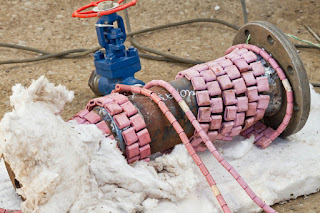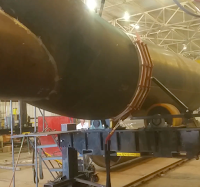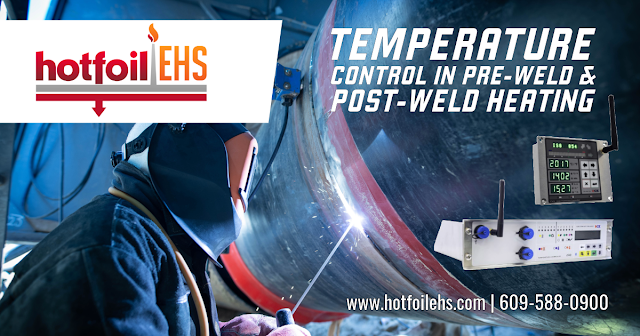A blog that provides educational information on electric heating systems used on hoppers, chutes, tanks and vessels; electric heating systems used for pre and post weld heat treating; heat treating power consoles; custom heat treating furnaces; and single & multi-operator welders. For more information, visit HotfoilEHS.com
Pre-weld Heating and Post-weld Heat Treatment: Essential Steps for Infrastructure Integrity
The Crucial Role of Part Temperature Control in Pre-Weld and Post-Weld Heating
https://hotfoilehs.com
609-588-0900
Pre and Post Weld Heat Treatment
Heat treatment in any large-scale welding process (such as pipeline welding, shipbuilding, boiler manufacturing) is critical to a weld's efficiency and, therefore, essential in a structure's performance, and therefore its importance can never be overlooked.
An examination of industrial code or a consultation with a welding specialist is imperative if in doubt. A review of the welding code is the first determinant of whether preheating is required. The welding code carefully defines the minimum preheat, the temperature, the soak time, and the welding method. Many requirements, all obtained from years of rigorously checked data, are recognized by welding codes. This data is well supported by several sources, including metallurgical research, chemical material properties, and radiographic analysis.
Welding heat treatment in its simplest form is the process of heating the base metal (parts to being welded) before welding to the desired temperature and then allowing it to cool at a given rate under regulated conditions. The exact temperature the component needs to achieve (before welding) is called the "preheat temperature."
There are several main reasons why preheating before welding is necessary. A preheated part cools more slowly, which slows down the welded part's overall cooling rate. This slow cooling strengthens the metallurgy (crystalline structure), which makes it less susceptible to cracking. Hydrogen that could be present immediately after a weld is therefore released more effectively, reducing cracking risk. Preheating at the weld joint and surrounding metal often mitigates stress from the shrinkage. It is preheating that decreases the risk of fractures due to brittleness during processing.
Electric preheaters for welding, known as "ceramic mat heaters," are durable and versatile heating components built to fit evenly around the weld and surrounding area. Ceramic mat heaters are temperature controlled by a power console that uses thermocouples and electronic controllers to regulate the preheat temperature profile, track it, and record the temperature data.
Another less favored method for heating the target piece is with a torch or open flame, but this method has apparent safety issues and controllability problems. Also used are heat treat furnaces, but these usually involve off-site transport of the target item.
For safety, portability, and controllability, induction heaters give an appealing alternative. Induction heating is endorsed because, instead of open flames or external electrical components, it uses molecular excitation as its source of heat. Induction heating operates very rapidly, and there are far fewer worries about component contamination since there is no interaction with the target item. When very high temperatures and uniform control is required, many industrial processes use induction heating.
It is critically important to review and discuss your heat treating requirements with an expert before welding. Don't risk safety or waste time and money by "winging it" when it comes to heat treatment.
Hotfoil-EHS
609-588-0900
www.hotfoilehs.com
Hotfoil-EHS Heat Treating Power Consoles
Precise control over your pre-weld and post-weld heat treatment parameters are critical. Accurate temperature control, specific soak times, uniformity, and controlled heat up and cool down times are required to ensure strong welds. Hotfoil-EHS power consoles are designed to provide the best control, easiest user interface, and longest lasting operation, even in the toughest environments. Using only the highest quality components, Hotfoil-EHS power consoles are field-tested and application proven. Control systems can be specified with or without recorders or ramping controllers, and are standardly available in 6, 9, 12, 18, and 24 zone configurations.
https://hotfoilehs.com
609-588-0900
New Hotfoil-EHS UK Ltd. Product Brochure
Pre Weld and Post Weld Heat Treatment
 |
| Welding between insulated heating areas Heating done by ceramic heaters (pink). |
An industry standard means of accurately managing the pre-heat and post-weld heat treatment is through the use of specialized electric heaters. Electric welding preheaters, known as "ceramic mat heaters", are rugged and flexible heating elements designed so that they conform uniformly around the weld and surrounding area. Ceramic mat heaters are normally controlled by a power console that uses thermocouples and electronic controllers to regulate, monitor, and many times record, the preheat temperature profile.
 |
| Ceramic heaters on spool piece. |
Before deciding to preheat or post heat any welding job, consult with a heat treating expert to make sure proper welding code requirements are being followed.
Induction Heating Basics
 |
| Induction heating coils around large pipe for pre-weld heat treatment. |
Direct Induction
Indirect Induction
Weld Heat Treatment is Critical to Structure Integrity
 |
| Welding pre-heat is critical to the quality of the weld and and the integrity of the structure. |
When in doubt, review of industry code or a consultation with a welding expert is imperative. Welding code is the first determinant to whether pre-heating is needed. Welding code carefully specifies the minimum preheat temperature, the soak time, and the welding process. Many criteria are considered by welding codes, all gathered from years of rigorously tested data. This data is accumulated from many sources, including metallurgical science, chemical properties of materials, and radiographic analysis.
In its simplest form, weld heat treatment is the process of heating the base metal (parts to be welded) to a desired temperature prior to welding, and then allowing it to cool at a given rate under controlled conditions. The specific temperature to which the part needs to be heated (before welding) is referred to as the “preheat temperature”.
There are several key reasons why it's important to preheat before welding.
- A preheated part cools more slowly, which slows the overall cooling rate of the welded part. This improves the metallurgical (crystalline) structure and makes it less prone to cracking.
- Hydrogen that may be present immediately after a weld is also released more efficiently, which further reduces the possibility cracking. Preheating also mitigates stress from the shrinkage at the weld joint and nearby metal.
- Pre-heating reduces the possibility of fracture during fabrication due to brittleness.
Another less preferred method to heat the target piece is with a torch, or open flame, but this method carries safety concerns as well as controllability issues. Furnaces are also used, but these typically require the transport of the target piece off-site.
Induction heaters offer an attractive alternative for safety, portability and controllability. Induction heating is unique because it uses molecular excitation as its source of heat, as opposed to open flames or external electric elements. Induction heating works very quickly, and since there is no contact with the target piece, there are far less concerns about part contamination. Many industrial processes use induction heating when very high temperatures and uniform control is desired.
Each welding application has it's own unique set of circumstances which dictate the optimal heat treating method. It is always best to contact an expert and solicit their opinion on your best available option.
Welding Heat Treatment Power Consoles
 |
| Welding Heat Treatment Power Consoles by Hotfoil-EHS |
Power consoles are standardly offered in 6, 9, 12, 18, and 24 zone configurations with a variety of control and recording systems. All Hotfoil-EHS power consoles are available in Stainless Steel and can be customize to your requirements.
Temperature recorders are available for applications requiring documentation and certification. Fully automatic controllers are provided when specific heat-up and cool-down profiles are needed.
EHS manufactures and sells accessories including:
- ceramic heaters,
- thermocouple attachment units (TAU)
- pin welders
- hardness testers
- thermocouple wire
- insulation
Applying Ceramic Mat Heaters for Pre and Post Weld Heat Treatment
The application of ceramic mat heaters is straightforward - the heater is placed directly on the part to be welded, insulation is normally laid over the heater, and voltage is applied. A thermocouple is tack-welded near to monitor the part. The part is brought up to temperature and then the welding is done. After the weld, the part is cooled at a controlled rate.
 |
| Welding a large pipe with localized heating using ceramic mat heaters. |
 |
| Preparing the pipe for the weld and allowing the heaters to raise the temperature of the pipe. |
 |
| Wrapping ceramic mat heaters around spool piece. |
 |
| Close-up of ceramic mat heaters around spool piece. |
Fusion45: New Rugged Induction Heater Improves Weld Quality
 |
| New Welding Induction Heater |
Induction heating works very quickly, and since there is no contact with the target piece, there are far less concerns about part contamination. Many industrial processes use induction heating when very high temperatures and uniform control is desired.
Pre and post-weld heat treating (stress relieving) is a growing market for induction heating systems because it offers significant benefits such as excellent heat placement and distribution, lower cycle times, safety, ease of use, and efficiency.
Induction heating can improve your bottom line by decreasing weld failures, and decreasing setup and tear down times. The technology allows for accurate temp control, without heavy electrical service or complicated controls. The portability and ease of use will allow you to heat more welds faster.
Custom Heat Treating Power Consoles Solve Many Potential Field Problems
 |
| Weather-proof, Stainless Steel Power Console |
Standard power consoles are available 3, 6, 9, 12, 18, 24 and 36 zone configuration (zones are many times referred to as "way" such as 3 way console, 6 way console, 9 way console, etc.) Each zone provides a point of control. The type of control can vary depending on the requirement of the weld. Some zones only need simple on-off or proportional control. Some welding jobs require more sophisticated temperature control profiles, thus requiring tight control with temperature vs. time ramping. Additionally, these more sophisticated control requirements may also need data logging or recording for quality compliance. In many situations custom cable sets are required to deliver the heater power and thermocouples to the workpiece. A power console manufacturer should have the experience and knowledge to consult, recommend, and install whatever zone control and cabling requirements your job needs.
 |
| Power console and custom cable sets |
 |
| Custom painted power console |
And of course, always try and find equipment built right here in the USA.
For more information on ANY welding power console, contact:
Hotfoil-EHS
2960 East State Street Ext.
Hamilton, NJ 08619
Phone # 609.588.0900
Fax # 609.588.8333
New Video on Ceramic Mat Heaters for Welding Heat Treating
Ceramic Pre Weld and Post Weld Heaters Get The Heat to the Weldment Efficiently
 |
| Ceramic mat heaters |
Design:
1) Sintered alumina oxide is formed into shapes and fired at precise temperatures to produce a ceramic insulator with a combination of high dielectric strength and efficient, fast heat transfer. This ceramic is also solid enough to withstand physical shock and resistance to oxidation and corrosion from a broad range of chemicals and atmospheres.
2) An accurately measured length of stranded nickel-chromium wire is precisely wound through the ceramic beads ensuring electrical isolation to produce a compact and flexible resistance heater. Suitable for operation at 2000 deg. F.
3) The resistance wire is then metallurgically bonded to a stranded nickel-copper wire to provide trouble free electrical continuity. The flexible stranded cold junction wire is connected to brass Twistlock connectors fitted with insulated sleeves. The cold junction extension leads are rated for 250 deg. C continuous temperature.
Ceramic mat heaters are efficient, time-tested, and proven heater technology in pre-weld and post weld heating, and are designed for the harsh realities of the welding environment.
For more information, contact:
Hotfoil-EHS, Inc.
2960 East State Street Ext.
Hamilton, NJ 08619
Phone # 609.588.0900
Fax # 609.588.8333
www.hotfoilehs.com
Rely on Experienced Welding and Heating Applications Experts for Improved Outcome and Efficiency
 |
| Work with the manufacturer's experts for better outcomes |
Manufacturers provide services that may help you save time and cost, while also achieving a better outcome for the entire project. Consider a few elements the technical sale rep brings to your project:
- Product Knowledge: Product managers and sales support personnel will be current on product offerings, proper application, and capabilities. They also have information regarding what products may be obsolete in the near future. This is an information source at a level not generally accessible to the public via the Internet.
- Experience: As a project engineer, you may be treading on fresh ground regarding some aspects of your current assignment. There can be real benefit in connecting to a source with past exposure to your current issue.
- Access: Through the manufacturer's internal applications people, you may be able to establish a connection to “behind the scenes” information not publicly available. The people at the manufacturer can provide answers to your application questions.
Develop a professional, mutually beneficial relationship with the manufacturer's technical sales team, and don't be shy to develop a professional and trusting relationship. Their success is tied to your success and they are eager to help you.
HofoilEHS - Your Preferred Source for Pre and Post Weld Heat Treating
The below video is a little shameless, self promotion.
Twin heating modules, with and without recorders, and optional ramping controllers are available from EHS.
EHS also offers short or long term rentals on power consoles, temperature recorders, and ceramic mat heaters along with complete support and training services.
Welding Preheat Basics
 |
| Why preheat welds? |
The area requiring preheat may be the whole (entire) part, or just the area immediately surrounding the weld.
Preheating may continue during the actual welding process, but many times the energy generated from welding will be sufficient to maintain the desired temperature. The temperature of the weld between the first pass and the last pass is referred to as “interpass temperature”. As long as it can be assured that interpass temperature will not fall below the preheat temperature, continued preheating is usually not required.
There are several key reasons why it's important to preheat before welding. First, a preheated part cools more slowly, which slows the overall cooling rate of the welded part. This improves the metallurgical (crystalline) structure and makes it less prone to cracking. Additionally, hydrogen that may be present immediately after a weld is also released more efficiently, which further reduces the possibility cracking. Preheating also mitigates stress from the shrinkage at the weld joint and nearby metal. Finally, pre-heating reduces the possibility of fracture during fabrication due to brittleness.
Electric welding preheaters, known as "ceramic mat heaters", are rugged and flexible heating elements designed so that they conform uniformly around the weld and surrounding area. Ceramic mat heaters are normally controlled by a power console that uses thermocouples and electronic controllers to regulate, monitor, and many times record, the preheat temperature profile.
Welding code is the first determinant to whether pre-heating is needed. Welding code carefully specifies the minimum preheat temperature, the soak time, and the welding process. Many criteria are considered by welding codes, all gathered from years of rigorously tested data. This data is accumulated from many sources, including metallurgical science, chemical properties of materials, and radiographic analysis.
Determining whether or not preheating is required should not be taken lightly, as it is critical to the quality of a weld and therefore critical to the performance of a structure. When in doubt, review of industry code or contacting an industry expert, is imperative.
Ceramic Mat Heaters for Pre & Post Weld Heat Treating
 |
| Ceramic mat heater for pre and post weld heat treatment. |
It's very important to pre-heat metal to a specific temperature prior to welding. Pre-heating metals reduces stress in the finished weld, as well as eliminates moisture and improves the metallic microstructure of the weld material. For post weld heat treatment (PWHT), use of resistance heaters to apply carefully controlled cool-down can significantly increase the cross-weld toughness of the heat-affected zone.
Ceramic mat heaters are manufactured using high grade nickel chrome (NiCr) 80/20 wire insulated with interlocking sintered alumina ceramic beads, providing flexibility and convenience for use on curved or flat surfaces. Their design also allows for good contact and high heat transfer. Ceramic mat heaters are intended for repeated use and have considerable mechanical strength and durability. They are capable of achieving temperatures of up to 2050°F. and are most often are supplied with ceramic insulated leads with either Camlock or Dinse type welder terminations.
The most common voltages used are 40, 60, and 80 volts (as supplied by arc welders) but many custom voltages are available. Special sizes, heating patterns and terminations are also easily accommodated with ceramic mat heaters.
Hotfoil-EHS, Inc.
2960 East State Street Ext.
Hamilton, NJ 08619
Phone # 609.588.0900
Fax # 609.588.8333
Email: dap@hotfoilehs.com



